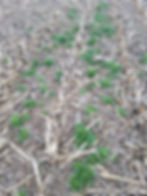The Importance of a Fall Burndown
- Rachel Stevens
- Nov 4, 2020
- 3 min read
With dry conditions and lots of good running days, many of you have experienced a shortened harvest season and have, or are wrapping up for the year. With harvest under your belts, you may be looking to fall fertilizer, anhydrous, and fall burndown. We wanted to help our with some of your fall burndown decisions today, so walk with us through some of our top 5 tips for planning for a fall burndown.

1. Questions to ask if you are considering a fall burndown
Some of you may be wondering if you even need a fall burndown. Most likely, if you are no-tilling, the answer is yes, you do. However, here are some more specific questions to think through to decide. How did the weed pressure look during harvest? Did you notice a heavy weed pressure in any field? And remember, the amount of weeds present is always more than you can see from the cab, so take that into account. Do you have a history of weed pressure, particularly winter annuals in your fields? Have you experienced any resistant weeds the past couple years? Do you ever have any trouble getting into the field in the spring in a timely manner? Perhaps some of the fields are poorly drained? Or just a challenge to keep up with all the spring activities? Think through these questions, and if you’ve had some of these challenges, we would urge you to seriously consider a fall burndown.

2. Applications are easier and smaller weeds are easier to control
We have several benefits from a fall burndown. The first is that small winter annual weeds are much easier to control at this size than the size they will be come spring. We will have a much better control if we can get them early. We are able to knock out the bulk of fall germinating weeds like marestail at this stage and have less of a battle in the spring and summer. Additionally, fall applications are generally less prone to compaction. This is true with our dry fall this year.
3. Agronomic Advantages
Reducing the mat of weeds that overwinters and starts rapid growth in the spring can lead to earlier planting. A thick mat of weeds can retain moisture and keep soils cool leading to a delay in planting. Reducing weed pressures can lead to a quicker drying and warming of soils.
Reducing our weed pressure can also help reduce our pest pressures and break cycles. Diseases and insects can overwinter in weeds through the winter. By eliminating this refuge, we can reduce the challenges we have with insects and disease in the coming year. This is even true for some challenging issues like soybean cyst nematode.
4. Fall burndown mix suggestions
Your fall burndown doesn’t have to be expensive or complicated. In fact we would encourage the opposite. We aren’t focused on any residual chemicals during this application. Those will be reserved for our spring application. A good place to start is with 2,4-D. Then add in one other chemical like dicamba, glyphosate, or metribuzin. Any of these combinations should provide a good control over fall annuals, even some showing roundup resistance. If you are thinking about price of applying a fall burndown and then another spring application, several sources have shown it is cheaper to apply both a fall and spring application, than skip the fall application and have to use a much more expensive mix in the spring to compensate. Just something to think about.
5. Timing of fall applications
You fall application can take place from now through early December. Even though we’ve had a cold week with several hard freezes, fall annuals are not dormant and will still respond to applications. In fact, many are moving nutrients to their roots to better overwinter, which makes them prime candidate for control. (They will move herbicides to their roots along with the nutrients and provide an excellent kill.) Apply on a warm day if possible when daytime temperatures are above 55 degrees and nighttime temperatures are above 40 degrees.
A few last thoughts. A fall burndown doesn’t eliminate the need for a spring application. We are still requiring that spring application to get a residual on and keep weed pressures down through the first part of the growing season. Our fall burndown makes that spring control possible. It is much harder to get a thorough control with just a spring application. These are just a few considerations for a fall burndown. Each field is unique and will require a specific recommendation. Talk to any one of the guys for advice for your fields.
Resources
